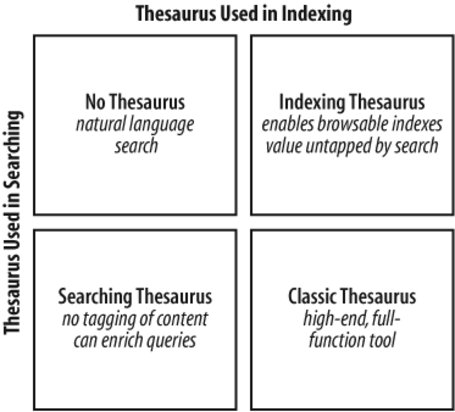Section 9.5. Types of Thesauri
9.5. Types of ThesauriShould you decide to build a thesaurus for your web site, you'll need to choose from among three types: a classic thesaurus, an indexing thesaurus, and a searching thesaurus (Figure 9-20). This decision should be based on how you intend to use the thesaurus, and it will have major implications for design. Figure 9-20. Types of thesauri 9.5.1. Classic ThesaurusA classic thesaurus is used at the point of indexing and at the point of searching. Indexers use the thesaurus to map variant terms to preferred terms when performing document-level indexing. Searchers use the thesaurus for retrieval, whether or not they're aware of the role it plays in their search experience. Query terms are matched against the rich vocabulary of the thesaurus, enabling synonym management, hierarchical browsing, and associative linking. This is the full-bodied, fully integrated thesaurus we've referred to for much of this chapter. 9.5.2. Indexing ThesaurusHowever, building a classic thesaurus is not always necessary or possible. Consider a scenario in which you have the ability to develop a controlled vocabulary and index documents, but you're not able to build the synonym-management capability into the search experience. Perhaps another department owns the search engine and won't work with you, or perhaps the engine won't support this functionality without major customization. Whatever the case, you're able to perform controlled vocabulary indexing, but you're not able to leverage that work at the point of searching and map users' variant terms to preferred terms. This is a serious weakness, but there are a few reasons why an indexing thesaurus may be better than nothing:
Such consistency of indexing can provide real value for information systems with captive audiences. When dealing with an intranet application that's used by the same people on a regular basis, you can expect these users to learn the preferred terms over time. In such an environment, indexing consistency begins to rival indexing quality in value. And finally, an indexing thesaurus positions you nicely to take the next step up to a classic thesaurus. With a vocabulary developed and applied to your collection of documents, you can focus your energies on integration at the user interface level. This may begin with the addition of an entry vocabulary to your browsable indexes and will hopefully bring searching into the fold, so the full value of the thesaurus is used to power the searching and browsing experience. 9.5.3. Searching ThesaurusSometimes a classic thesaurus isn't practical because of issues on the content side of the equation that prevent document-level indexing. Perhaps you're dealing with third-party content or dynamic news that's changing every day. Perhaps you're simply faced with so much content that manual indexing costs would be astronomical. (In this case, you may be able to go with a classic thesaurus approach that leverages automated-categorization software, as described in Chapter 16.) Whatever the case, there are many web and intranet environments in which controlled vocabulary indexing of the full document collection just isn't going to happen. This doesn't mean that a thesaurus isn't still a viable option to improve the user experience. A searching thesaurus leverages a controlled vocabulary at the point of searching but not at the point of indexing. For example, when a user enters a term into the search engine, a searching thesaurus can map that term onto the controlled vocabulary before executing the query against the full-text index. The thesaurus may simply perform equivalence term explosion, as we've seen in the case of synonym rings, or it may go beyond the equivalence relationship, exploding down the hierarchy to include all narrower terms (traditionally known as "posting down"). These methods will obviously enhance recall at the expense of precision. You also have the option of giving more power and control to the usersasking them whether they'd like to use any combination of preferred, variant, broader, narrower, or associative terms in their query. When integrated carefully into the search interface and search result screens, this can effectively arm users with the ability to narrow, broaden, and adjust their searches as needed. A searching thesaurus can also provide greater browsing flexibility. You can allow your users to browse part or all of your thesaurus, navigating the equivalence, hierarchical, and associative relationships. Terms (or the combination of preferred and variant terms) can be used as predefined or "canned" queries to be run against the full-text index. In other words, your thesaurus can become a true portal, providing a new way to navigate and gain access to a potentially enormous volume of content. A major advantage of the searching thesaurus is that its development and maintenance costs are essentially independent of the volume of content. On the other hand, it does put much greater demands on the quality of equivalence and mapping. If you'd like to learn more about searching thesauri, try these articles:
|
EAN: 2147483647
Pages: 194